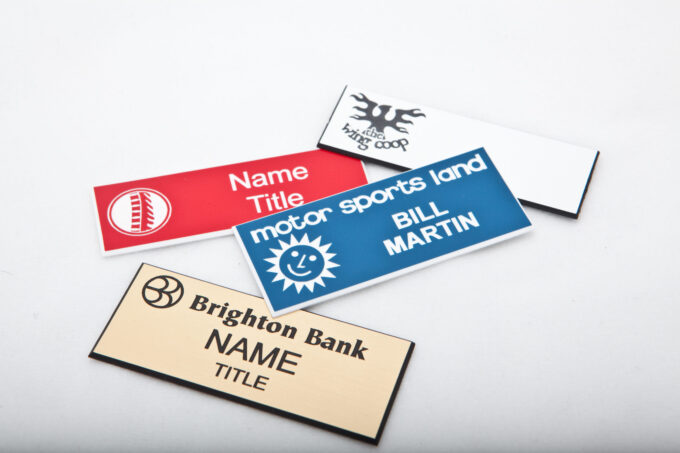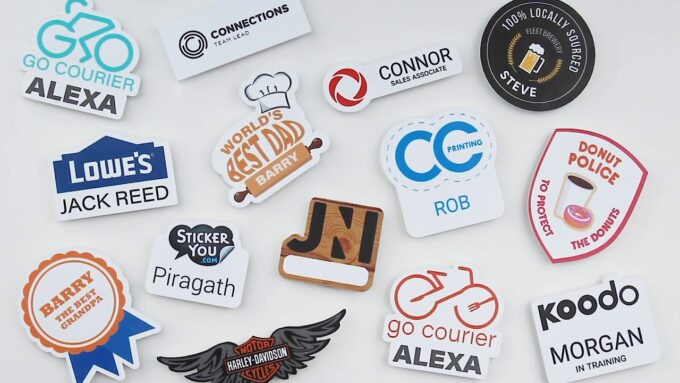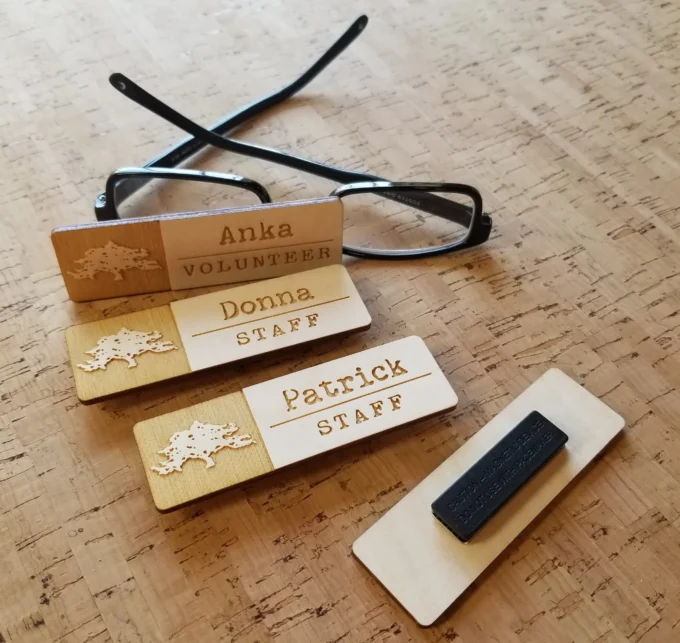Are you looking for an innovative way to connect with your customers and turn them into loyal brand advocates?
Custom name badges unlock the power of personalization, allowing you to build meaningful connections and maximize the impact of your marketing efforts. In this guide, we’ll show you how to make the most of custom name badges.
Benefits of Custom Name Badges

Custom name badges can be powerful marketing tools for businesses. They can project professionalism, help staff to engage more with customers, and serve as walking billboards for your company.
Custom name badges come in a variety of styles, materials and sizes to meet the needs of any business. PVC name badges are popular because they are lightweight, durable and waterproof. They also look professional when customized with a logo or message. Glass-like acrylic name badges come in unique shapes and sizes that can be colored or topped with digitally printed graphics to create stunning customized pieces that reflect your brand values. Metal name badges are solid and classy, offering longevity while maintaining a modern style.
Customizing them amplifies their impact – they make an immediate visual impression that strengthens brand recognition among customers or potential customers. Staff will feel empowered having their individual names displayed on their uniform, increasing morale and enhancing company loyalty. Custom names can clearly denote employees’ roles and responsibilities within the organization – helpful to visitors who may have difficulty identifying who is who in the office or store layout – while helping differentiate between similar staff members such as reception assistants or sales associates at department stores. In branding terms, tailored name tags are walking ambassadors for a business; just one more way companies can keep their customers engaged beyond traditional advertising mediums like print media or television commercials.
Design Considerations for Name Badges

Design considerations for name badges are important to think about when looking to make a more effective, personalized presence for your business. With the right placement of color, text size/quality, shape, and other elements you can create a stronger brand identity that customers will understand and recognize.
Some of the key elements to consider include font size/style, highlighting important information such as titles or company names, choosing between horizontal or vertical alignment to best optimize the space on the badge without overcrowding it with too much information or making it look cluttered and jumbled. Additionally you should consider using color to highlight different levels of importance between information on the badge—higher titles should be given a darker shade while lower titles should be kept light – or consider embossing text to make certain parts stand out without being overwhelming. Choosing materials that complement each design element can also influence the appeal and readability of name badges—so choose sturdy, durable materials that won’t wear down easily over time.
Finally, choosing between shapes for them can offer options for greater customization: adding ergonomic curves for comfortable wrap-around wears or making sure you have enough real estate for more detailed designs. No matter which design route you choose, your approach should focus on creating an eye-catching look that doesn’t overpower customers but calls attention in exactly the way you’d like them to notice.
Best Practices for Implementing Name Badges

They can be a great tool to help differentiate the customer experience and build personal connections with customers. However, it is important to consider the best practices for implementation in order to maximize their effectiveness.
The first step in implementing a successful personalized name badge program should be an assessment of your business’ current customer service strategy and identifying any areas where further personalization may bring additional value. This assessment should also consider the way customers currently interact with staff and identify any potential improvements that could be made using name badges.
Once you have determined how you would like your name badge program to look, it’s important to select an appropriate material for manufacturing. It’s advisable to find a material that will not only identify employees, but also give a professional impression and provide easy maintenance over time.
The next step is designing the badge itself with an eye-catching design that allows customers to easily recognize employees when they walk into a store or meet them at an event. A visually appealing design should also not interfere with readability, instead adding depth and character to ensure each customer has positive interactions with your staff members wearing them.
Finally, make sure your staff feel comfortable wearing their name badges by providing conversations about their importance during onboarding or regular training sessions. This will ensure everyone understands why these personalized identifiers are necessary and important for building strong customer relationships when they are out in the field or working with customers in person. With these steps taken into consideration, it is much more likely that customers will appreciate being able to connect names with faces, knowing they are receiving direct service from uniquely identified members of your team – leading towards increased loyalty from both existing and new customers alike!
Challenges of Personalization in Business Marketing

Customizing a company’s products and services for each customer is known as personalization. This strategy has become a widely implemented form of business marketing. The advantages of personalizing can include improved customer loyalty, higher sales, satisfied customers, and more efficient operations.
Personalization in business marketing brings unique challenges, however. Many businesses find that data overload, poor analytics, ineffective databases, and limited technology impede their success in providing custom names, badges or other personalized products and services. Additionally, customers may be hesitant to share certain data with companies for fear of privacy violations or misuse of information.
Further challenges include the costs associated with maintaining accurate customer preferences and identity data; sourcing reliable supplier partners; determining when personalization is effective versus when it does not offer sufficient value; addressing legal requirements to protect sensitive data; careful monitoring of customer contact preferences; and implementing organizational change to enable successful personalization strategies.
Nevertheless, many organizations are discovering the power of utilising customized services to achieve greater customer loyalty and increase their profits by providing a higher level of service to each individual customer. To successfully implement personalized services into your business marketing strategy requires time-consuming effort but can result in higher levels of success if done correctly.
Conclusion
In today’s competitive business environment, it is essential to stand out from the competition and make a lasting impression on customers. One of the easiest and most effective ways to do this is through personalization. Personalizing name badges for your employees can help customers remember you and your business, making it more likely that they will become repeat customers.









